HLF 2018: Women in Mathematics Throughout Europe, An Exhibition
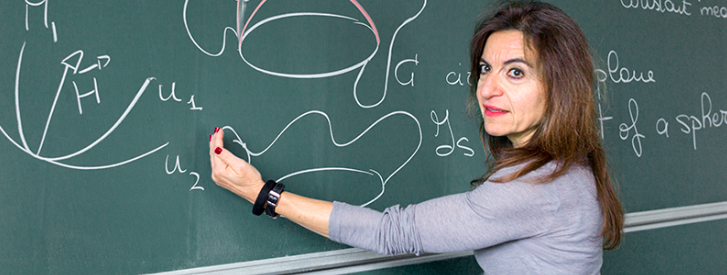
HLF 2018 — “Don’t you know? Mathematics isn’t feminine.”
It’s the kind of backward, old-fashioned comment one can imagine a little girl getting in the midst of a 1950s elementary school math competition. But Nilanjana Datta, now a noted Univ. Of Cambridge quantum information theorist, says she was in her 20s and an ETH Zurich grad student when someone said that to her. And it happened in the 1990s.
 Gender bias in mathematics isn’t always so explicit but it is nonetheless an ugly reality, say organizers of Women in Mathematics Throughout Europe, a traveling photo exhibition in Heidelberg this week on occasion of the sixth annual Heidelberg Laureate Forum (HLF 2018). The exhibit features 13 women mathematicians who’ve made great contributions to the field and whose success may inspire girls and women to follow in their steps.
Gender bias in mathematics isn’t always so explicit but it is nonetheless an ugly reality, say organizers of Women in Mathematics Throughout Europe, a traveling photo exhibition in Heidelberg this week on occasion of the sixth annual Heidelberg Laureate Forum (HLF 2018). The exhibit features 13 women mathematicians who’ve made great contributions to the field and whose success may inspire girls and women to follow in their steps.
The creation of the exhibit grew “from the observation that, nowadays, women still find it difficult to embrace a career in the mathematical academic world and (that) the disparity between the proportion of men and that of women among professional mathematicians is still shamefully large,” according to the organizers. In the interviews and portraits displayed here, it is a common theme.
“I now realize from my experience as a mentor for young women mathematicians that women have more doubts about themselves than men do,” said Katrin Wendland, a quantum field theorist from the Univ. of Freiburg and one of the women mathematicians highlighted here. “I kept myself going by thinking that, since I had the privilege over many others to have gone that far, it was my duty to keep going.”
But while that feeling of duty was critical then, it is the joy she derives from math that continues to drive her. “The moment I enjoy best is when the pieces of the puzzle fall into a coherent whole,” she said.
So many of the mathematicians interviewed for the exhibit echoed that sentiment.
It’s worth noting that the featured mathematicians do revolve depending on the venue — Datta, for instance, was included in the Univ. of Cambridge version of the exhibit earlier this year.
Here’s a list of the mathematicians honored here this week with links to their research and work.
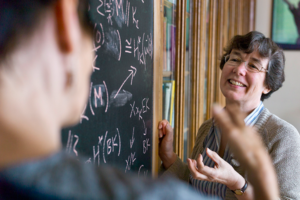 DAME FRANCES KIRWAN
DAME FRANCES KIRWAN
Now the Savilian professor of geometry at the Univ. of Oxford, Dame Frances specializes in algebraic and symplectic geometry. It’s paid off. She’s perhaps best known for her creation of the so-called Kirwan map, or for her role as the president of the London Mathematical Society (2004-06), the second-youngest in the society’s long history.
In 2013, she won that society’s coveted Senior White House prize and was named Dame Commander of the British Empire for her contributions to mathematics a year later.
NALINI ANANTHARAMAN
The winner of the Henri Poincaré Prize in 2012 for her work, with Freeman Dyson, Barry Simon and Sylvia Serfati, on quantum chaos and dynamical systems work, Anantharaman chairs the mathematics department at the Univ. of Strasbourg.
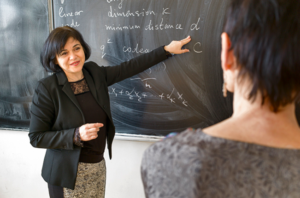
STEFKA BOUYUKLIEVA
A professor of mathematics and informatics at Bulgaria’s Veliko Tarnovo University. Stefka’s research centers on algebra, coding theory, combinatronics, error correction and other various aspects of cryptography.
ALICE FIALOWSKI
Functional analysis, deformation, representation, cohomology and Lie theory are among the long list of research interests of Fialowsky, a native Hungarian who these days performs her research at the University of Pécs, Eötvös Loránd University.
KAISA MATOMÄKI
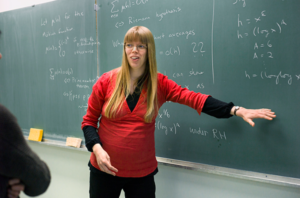 As an academic research fellow in the department of math and statistics at the Univ. of Turku in Finland, Matomäki specializes in number theory, including multiplicative number theory, prime numbers and additive combinatorics.
As an academic research fellow in the department of math and statistics at the Univ. of Turku in Finland, Matomäki specializes in number theory, including multiplicative number theory, prime numbers and additive combinatorics.
In 2016, she and Maksym Radziwill were awarded the SASTRA Ramanujan Prize, which honors young mathematicians who work in areas pioneered or influenced by famed mathematician Srinivasa Ramanujan.
MARGARIDA MENDES LOPES
At the University of Lisbon, Portugal, Medes Lopes focuses on algebraic geometry, particularly as it relates to the classification of projective varieties, surfaces of general type and bicanonical maps.
Watch her lecture on the behavior of curves on irregular surfaces here.
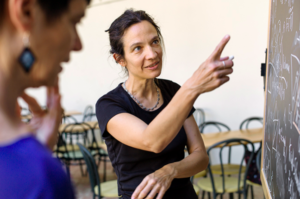
KARIN BAUR
Baur chiefly focuses her energies on cluster algebras, surface algebras and combinatorial methods in representation theory. Find a selection of her research work at the University of Graz here.
DUŠANKA PERIŠIĆ
Perišic is a mathematics professor at the Univ. of Novi Sad in Serbia, where she researches problems involving functional analysis and generalized function theories. Find a sampling of her research papers here.
IRINA KMIT
On the faculty of mathematics and natural sciences at the Humboldt University of Berlin, Kmit focuses most on mathematical analysis regarding hyperbolic differential equations, boundary value problems, bifurcation as well as stability analysis.
BARBARA NELLI
Nelli is a native Italian who conducts research in such fields as differential geometry, geometric analysis and geometrical problems involving constant mean curvature surfaces. She is a professor in the department of engineering, information sciences and mathematics at the Univ. of L’Aquila.
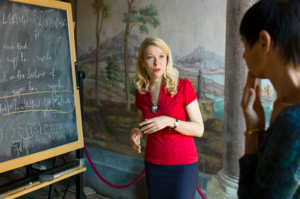
KASIA REJZNER
Originally from Poland, Rejzner primarily delves into mathematical physics, operator algebras, algebraic quantum field theory and renormalization at the Univ. of York.
Find a selection of her papers and other work here.
KATRIN WENDLAND
Specializing in geometry and quantum field theory, Wendland is a mathematical physicist at the University of Freiburg. In 2009, the Bavarian government awarded her its Medal for Special Merits for her work in mathematics.
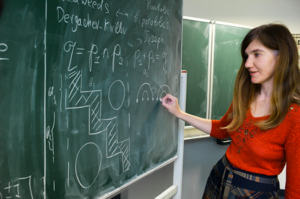
OKSANA YAKIMOVA
A professor and researcher at the University of Jena, Germany
Yakimova primarily specializes in algebraic groups, Lie algebras, Poisson structures and harmonic analysis on Gelfand pairs. Check out a sampling of her research work here.
For HLF 2018 in Heidelberg, Germany, I’m Gina Smith.
Cover image of Italian mathematician Barbara Nelli and all images of the women mathematicians: WomenInMath.net.Top image of the Women of Mathematics gallery opening in Heidelberg: © Heidelberg Laureate Forum Foundation / Mück


When I was in elementary school I remember the girls singing, “boys have the muscules, girls have the brains.” The funny thing is neuroprosthesis technology is getting good and so are high speed, high torque, self-reconfiguring robots, partly due to mathematics and geometry and partly due to physics, chemistry and biology, to start with.
Mathematics can be made poetic or terminally confusing, depending on what the mathematician, trigonometer, geometer or whoever does with it.
The mathematics used in the first A-bomb, bioprint designs, main stream clothing designs (sneakers, work boots, flip flops) and by the way, special relativity, which was Albert Einstein’s wife’s idea, but she didn’t care if he used it, schools, etc… have played a dominating role and have made a major impact on the way that we live our dayly lives, especially the internet, which proves that if somebody wants to learn alot of mathematics and geometry bad enough, now is the best chance in all of history, whether construed as feminine, nonfeminine, masculine, nonmasculine or artistic, romantic…. any which way that you look at it, the internet, at the time of this writing, is greatest opportunity to learn more and more mathematics and geometry, if whomever wants to learn it, wants to learn it bad enough.